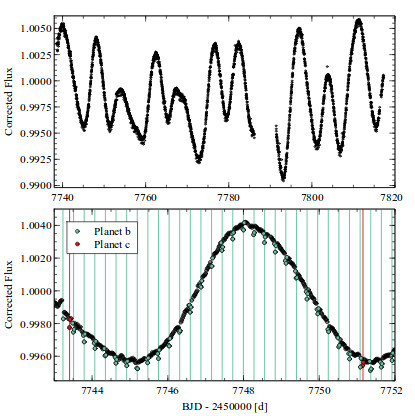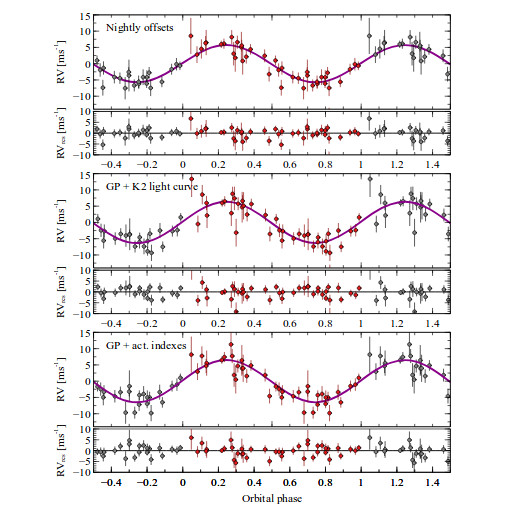K2-141b: An ultra-short period rocky super-Earth
Two international teams of astronomers have discovered a planet with the radius similar to that of the Earth and a mass 5 times greater. It orbits around the dwarf star named K2-141. An important characteristic of the new planet, named K2-141b, is its orbital period of just 6.7 hours, the shortest period ever measured for a planet with known internal composition. K2-141b has been independently characterized by HARPS-N GTO Collaboration, using data obtained with the high resolution spectrograph HARPS-N installed at the Telescopio Nazionale Galileo (La Palma, Islas Canarias), and the KESPRINT Consortium, using data from HARPS (La Silla, Chile). Both teams have identified the planet in the K2 light curve using the transit method.
Planets with mass and radius only slightly bigger than our planet are called super-Earths, and when they orbit their star with a period smaller than one day, they take the name of ultra-short period (USP) planets. The formation and evolution history of these planets are still unclear, and precise determinations of the internal composition, obtained by comparing the measured mass and radius with theoretical models, are required to understand their origin. Less than twenty super-Earths have precise mass and radius measurements, and only half of them have period shorter than one day, after including K2-141b. With a radius of 1.5 REarth and a mass of 5.1 MEarth, K2-141b has a composition similar to that of Earth, with an Iron fraction between 30% and 50% and the remaining part in silicates.
There’s more than that, however. "By carefully analyzing the K2 light-curve we found that K2-141b is not alone", says Luca Malavolta, post-doc at University of Padova and lead author of the paper from the HARPS-N GTO Collaboration. “A second transiting planet has been identified in the K2 light-curve with a mass below 7 Earth masses and farther from the star than the other planet. Its radius cannot be precisely determined, but our results suggest that K2-141c is more likely a mini-Neptune or a Neptune-like planet with a thick gaseous envelope than a rocky one. The discovery of an outer companion supports the idea that USP super-Earths form through planetary migration, differently from Hot Jupiters which only rarely have a nearby companion”. In such a context, the HARPS-N measurements played a fundamental role, allowing a more complete characterization of this exceptional extrasolar planet.
K2-141b will be also remembered for being the fourth super-Earth with the detection of its secondary eclipse, after 55 Cnc e, Kepler-78b and Kepler-10b. This effect has been identified by the HARPS-N GTO team by carefully analyzing the K2 light-curve. The measured occultation depth is 23±4 ppm, meaning the secondary eclipse and phase signal are confidently detected at over 5σ significance. The detected signal is compatible with either the presence of a cloudy atmosphere (geometric albedo of 0.30±0.06 in the Kepler bandpass) or thermal emission from the surface at a temperature at around 3000 Kelvin, with any combination of the two scenarios still compatible with the data. They also found a strong temperature difference between the irradiated side and the night side of the planet, which is tidally locked with its star, and this lack of thermal redistribution and theoretical considerations seem to support the thermal emission from molten rocks and exclude the presence of a cloudy atmosphere, which would redistribute the eat on the night side of the planet. Only high-precision photometry with the Hubble Space Telescope and the forthcoming James Webb Space Telescope will be able to uncover the true nature of Kepler-141b

Top: K2 light curve of K2-141. Bottom: A portion of the light curve is shown to highlight the two transiting planets.

Phase-folded RV fit with residuals coming from HARPS-N data.
Useful links:
K2-141 b: A 5-M⊕ super-Earth
transiting a K7 V star every 6.7 hours
An ultra-short period rocky
super-Earth with a secondary eclipse and a Neptune-like companion around
K2-141
TNG Contact: dydat@tng.iac.es

